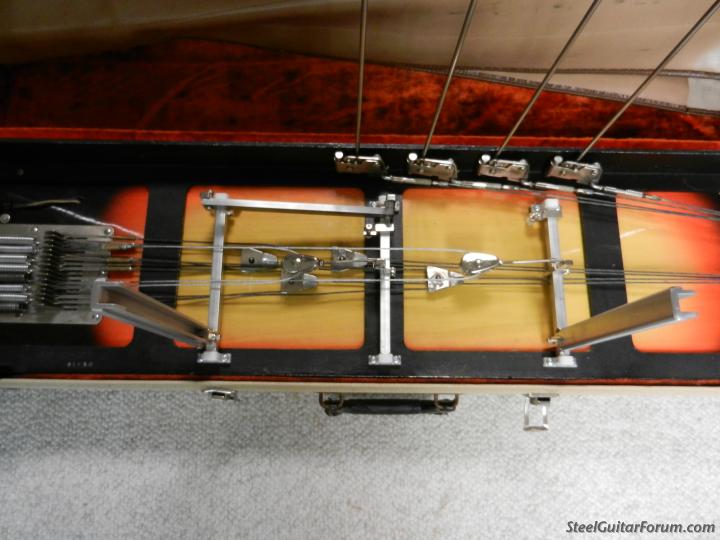My recently purchased 400 has 4 pedals, and I originally set it up E9 with pedal 1 E-F, pedals 2 and 3 the AB pedals, and the fourth pedal lowering E-D#. With no levers, this works OK but its limited and it was hard to work around my muscle memory of having and using levers. I disassembled and cleaned the changer when I got the guitar, and was pleasantly surprised about how accurate all the changes and returns are working, but the lack of levers was frustrating.
Some thoughts on the copedent:
-Without the top two chromatic strings of 10 string E9, adding two levers raising and lowering the Es would be adequate I decided, and I do those Paul Franklin style so both levers are non reversing, LKL and RKL.
-I also decided to stay within the single raise/single lower and not have half stop tuners under the guitar.
-I wanted it to as close to my full 10 string setup so there is no confusion playing one or the other. Not having the top two strings is easy calibrate to, but I did not want to have to relearn pedals and levers.
The full 4+2 setup is this:
[tab]
________________LKL____ P1_____P2_____P3______P4______RKL________
1__G#__.011_____________-G____________+A________________________
2__E___.014_____+F____________________________________-D#________
3__B___.018___________________++C#___________-A#________________
4__G#__.022w____________-G____________+A________________________
5__F#__.026_____________________________________________________
6__E___.030_____+F____________________________________-D#________
7__D___.034__________________________________-C#________________
8__B___.038___________________++C#______________________________
[/tab]
Pedals 1, 2, 3, and the levers are exactly as I normally play. I am experimenting with pedal 4 but basically I am using it for the “missing” changes from my 10 string setup. Currently pedal 4 plus E to D# gives a nice pentatonic across strings 7 to 3 plus some other moves. I am missing string 7 F# to G on RKR and may add a single pull lever to get that at some point, raises are much easier to deal with on 400s.
Cable Assembly
-Brass tube and .055 music wire were purchased from a K & S Metals display at my local electronics store, also available at McMaster Carr
-A pulley and 1/16 wire rope from Home Depot, pulley eye was ground off and a 3-48 hole tapped
-The music wire changer clips, brass tube, and wire rope were connected using acid core silver bearing solder
Knee Levers
-I purchased cross shafts, pillow blocks, bell cranks, rods and stops from Williams Guitar Company.
-The pull rods were cut to length and threaded 3-48 to mate with the pulley.
Gear Up Assemby
You will notice a third crossshaft, that is present to gear up the travel for the long travel required to lower on these guitars. For a semitone drop (dropping E to D#) the finger itself must move 3/8 inch or so, which translates into a ridiculous amount of travel for a direct acting lever with a normal height bellcrank. With the gear up, I have right at 1 inch of travel at the point my leg touches the RKL lever, matching the travel of the LKL E to F change (the raise finger only needs to pull about 1/8 inch by the way).
On the gear up linkage, I originally tried a normal .094 diameter pull rod, but it was way too flexible to work in compression as this linkage must. My plan B was drill the bellcrank holes to 1/8 diameter and use two shoulder screws and a ¼ x ½ flat bar for the link. The ¼ x ½ size is overkill, but I had it laying around, I would recommend 3/16 X 3/8, that would be plenty strong. Also note I turned the bellcranks so the force is applied to stronger part of the bellcrank (since the rod holes are off center).
The other important point to making this work is changing out the return springs.
Return Springs
The stock Fender springs are much stronger than needed, and combined with the long travel required for lowering make for long and stiff action. The stock springs are .056 inch wire, so the spring rate (lbs per inch of extension) is too high in addition to the high preload. The answer is smaller wire diameter springs with enough preload to hold the lower fingers against the stop. That way, the force to actuate the pedal or lever is not too high.
For pedal lowers I used .048 inch wire springs sourced from McMaster, part number 9654K213, its 2.75 inch long 3/8 diameter, you can straighten out one of the loop ends and make the small hook required. For a little more resistance, you can use the 2.50 inch long version part number 9654K212 .
For the RKL, I needed an even softer spring to get the feel of the lever correct (ie not too stiff). I found a .344 diameter .041 wire size spring at my local Ace Hardware, it was #20 in the drawers, and they come from Hillman who supply all the nuts/bolts/screws/etc at Ace. It was longer than I needed, so I had to unwind several coils and remake the hook to get the right preload. The key is the spring rate in lbs per inch for the .041 wire is correct for good lever feel.
To straighten and remake the hooks requires two needlenose pliers, perhaps a vise, a lot of patience, and probably a few extra springs in case you screw up, but the difference in action is amazing.
Another mod I did for playing ergonomics was to round the edges of the pedals, see the pic. The pedal edges are sharp from the casting process and some of the paint was worn off anyway, so I rounded the edges and sanded the top for better appearance and playability. Many modern guitars have sharp edged pedals also, but I personally hate this.




